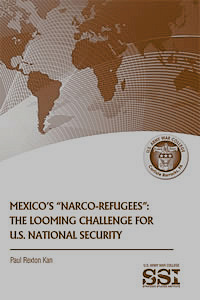The impacts of Mexico’s “War on Drugs” in recent years have been apparent in many parts of the country, particularly in the Mexico-USA border region. Apart from the obvious and well-documented increased levels of violence in several northern border states, we have looked briefly in a previous post at how some businesses closed their factories or offices in northern Mexico and relocated to the relative safety of Mexico City and central Mexico. Individuals living in the areas where drug-related violence has increased have also had tough choices to make, and many families have chosen to move, either to other areas of Mexico or to the USA or Canada.
 Canada recorded a sharp spike in the number of Mexicans entering the country and claiming asylum on the grounds that their lives were in danger if they returned to Mexico. The number rose from 2,550 in 2005 to 9,309 in 2009, with about 10% being accepted as legitimate claims. Canada’s response to the sudden increase in applicants was to impose strict visa restrictions which made it far harder for Mexicans to enter Canada legally. The changes led to an 80% drop in the number of Mexicans applying for asylum in 2010.
Canada recorded a sharp spike in the number of Mexicans entering the country and claiming asylum on the grounds that their lives were in danger if they returned to Mexico. The number rose from 2,550 in 2005 to 9,309 in 2009, with about 10% being accepted as legitimate claims. Canada’s response to the sudden increase in applicants was to impose strict visa restrictions which made it far harder for Mexicans to enter Canada legally. The changes led to an 80% drop in the number of Mexicans applying for asylum in 2010.
Several US border cities have also experienced an influx of Mexican migrants. In Mexico’s “Narco-Refugees”: The Looming Challenge for U.S. National Security, Dr. Paul Kan, Associate Professor of National Security Studies and the holder of the Henry L. Stimson Chair of Military Studies at the U.S. Army War College, looks at how Mexican “narco-refugees” (who leave Mexico “unwillingly”) could influence US policymakers and force them to reconsider national security priorities.
Dr. Kan considers three alternative scenarios, which, he argues, “would force the narco-refugee issue onto the [US] national policy-making agenda”:
- 1. the “new normal”, in which drug-related violence in the USA and Mexico becomes “a fact of life in relations between the two countries”, as drug gang and cartel activities spread into the USA along the corridors used to transport drugs.
- 2. an “accidental narco” syndrome developing in Mexico, in which the Mexican government, in order to demonstrate its commitment towards lowering cartel violence, may collude with one or more smaller cartels to help gain intelligence about the larger, more violent cartels prior to clamping down on them. Such a policy could lead to a sharp increase in the number of narco-refugees, as the core areas of stronger cartels see increasing violence as the cartels fight for survival.
- 3. the emergence of a “Zeta state.” In this third scenario, a kind of “parallel state” emerges, in which private security firms play a much larger part as wealthy Mexicans seek to protect themselves, relying on their own resources, rather than on the government’s law and order or security forces.
As Dr. Kan emphasizes, these three scenarios are not mutually exclusive, and could coexist in different areas of the country simultaneously. Equally, some parts of the country might escape the effects of all three of the scenarios he analyzes.
Kan repeats anecdotal and other evidence which suggests that “narco-refugees” are becoming an important trend, with serious consequences for Mexico’s economy. For example, “One young Mexican executive at cement giant Cemex SAB, which has headquarters in Monterrey, said he can count at least 20 different families from his circle of friends who have left—nearly all of them for nearby Texas.” Reduced US investment in Mexico is not a good sign. According to the US Chamber of Commerce in Mexico, 25% of its members are “reconsidering their investments in Mexico as a result of worries over security”, with 16% having suffered extortion and 13% having experienced kidnappings. According to J.P. Morgan’s chief economist for Mexico, “the country likely lost approximately $4 billion in investment in 2010 when companies reconsidered such plans because of drug violence.”
At a more local level, in Ciudad Juárez, “more than 2,500 small grocery stores have closed due to extortion or because customers have left the city; the Mexican social security administration believes that 75,000 residents there have lost their jobs since 2007.”
Clearly, the impacts of Mexico’s “war on drugs” are far-reaching. Let’s hope that the situation improves in 2012, despite it being a year of federal elections in both Mexico and the USA.
Previous posts about the geography of drug trafficking and drug cartels in Mexico:
- Drug violence: is it safe to travel to Mexico?
- The geography of drug trafficking in Mexico
- The background to Mexico’s fight against drug cartels
- Mexico’s export trade in drugs
- The economic benefits to Mexico of the drugs trade
- Mexican drug traffickers expand their influence to Central America
- More impacts of Mexico’s war against drug cartels
- Drug gangs diversify their business activities
Sorry, the comment form is closed at this time.